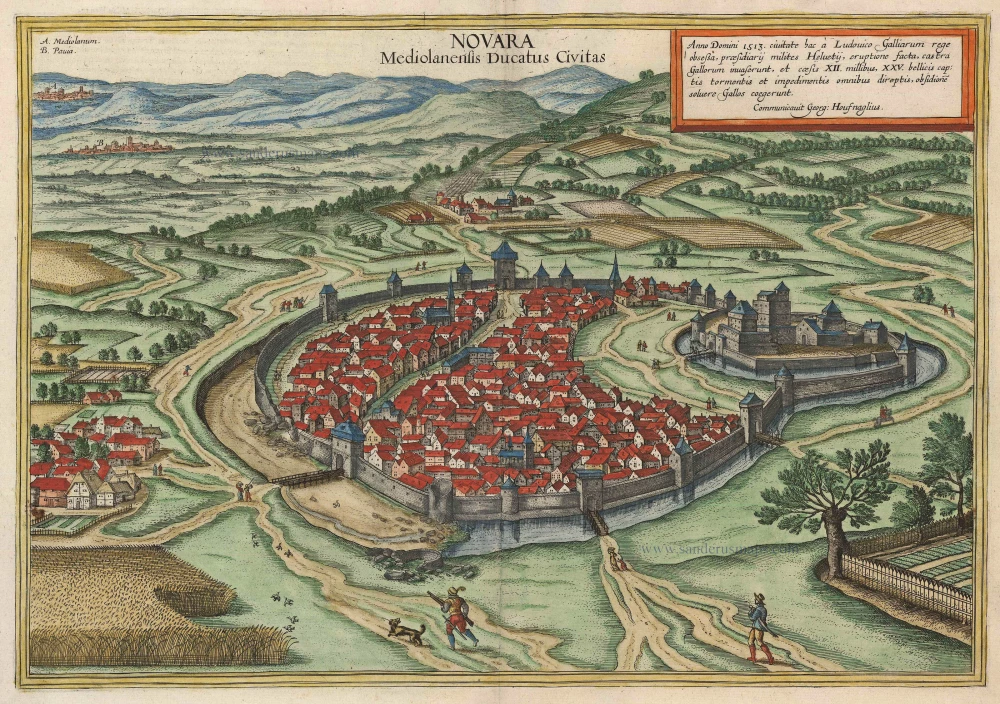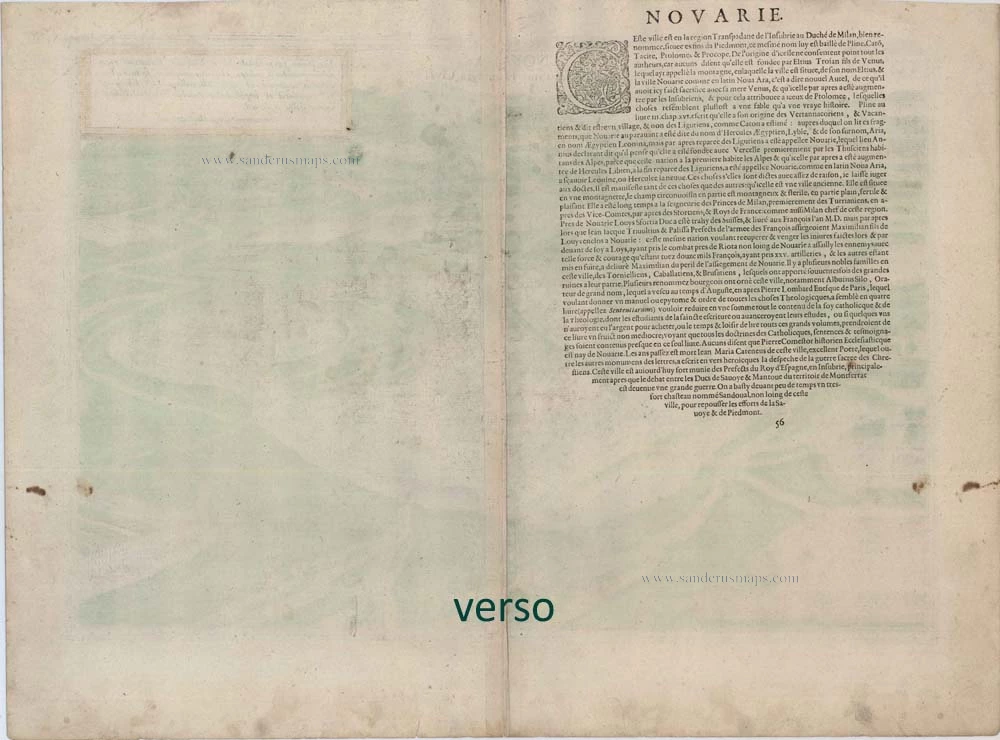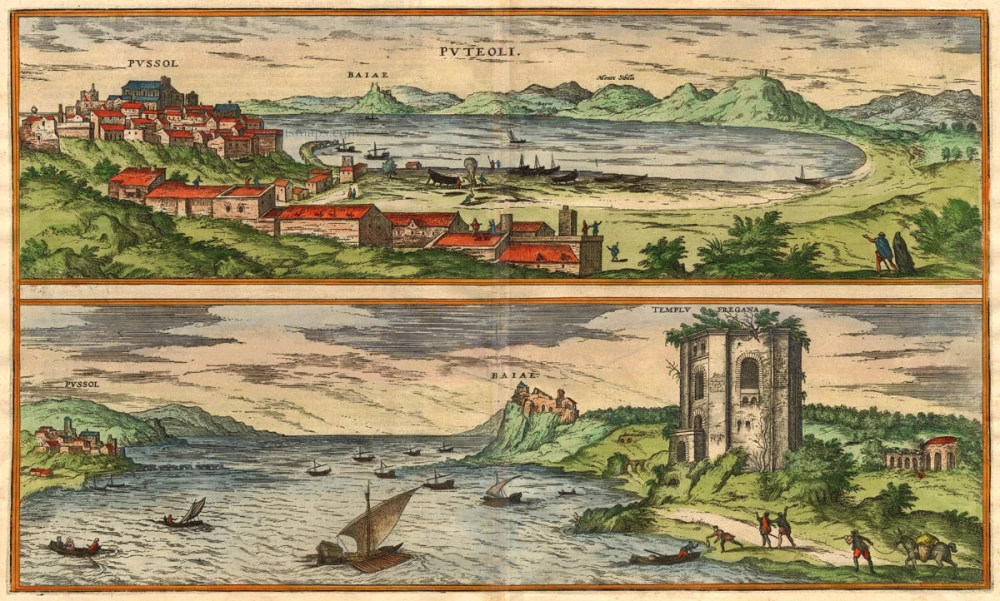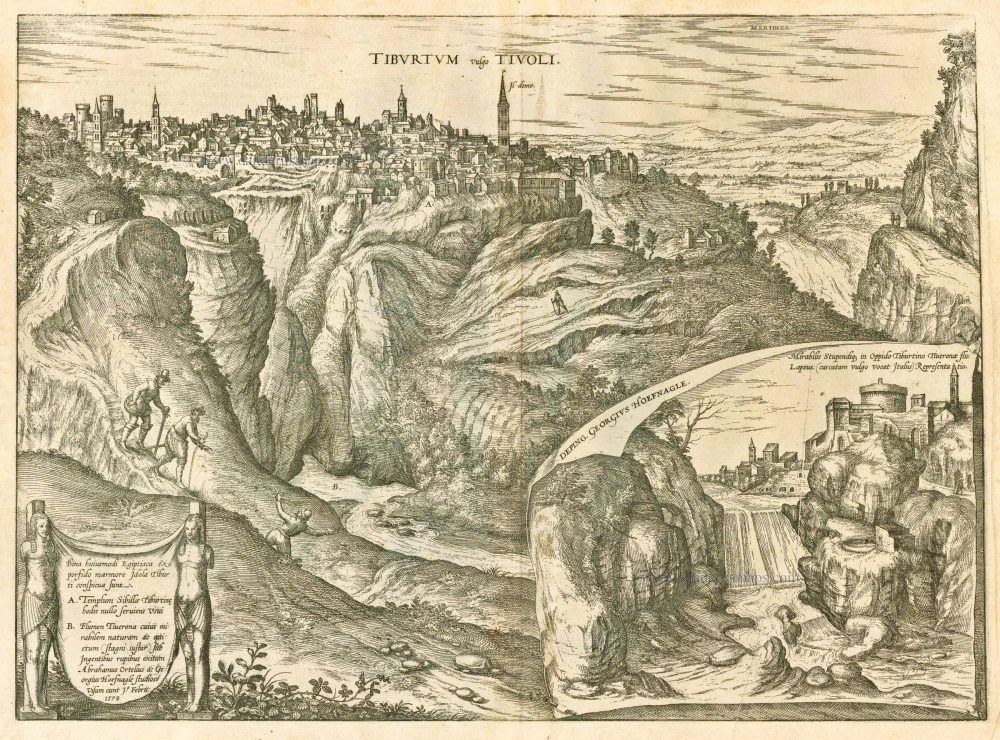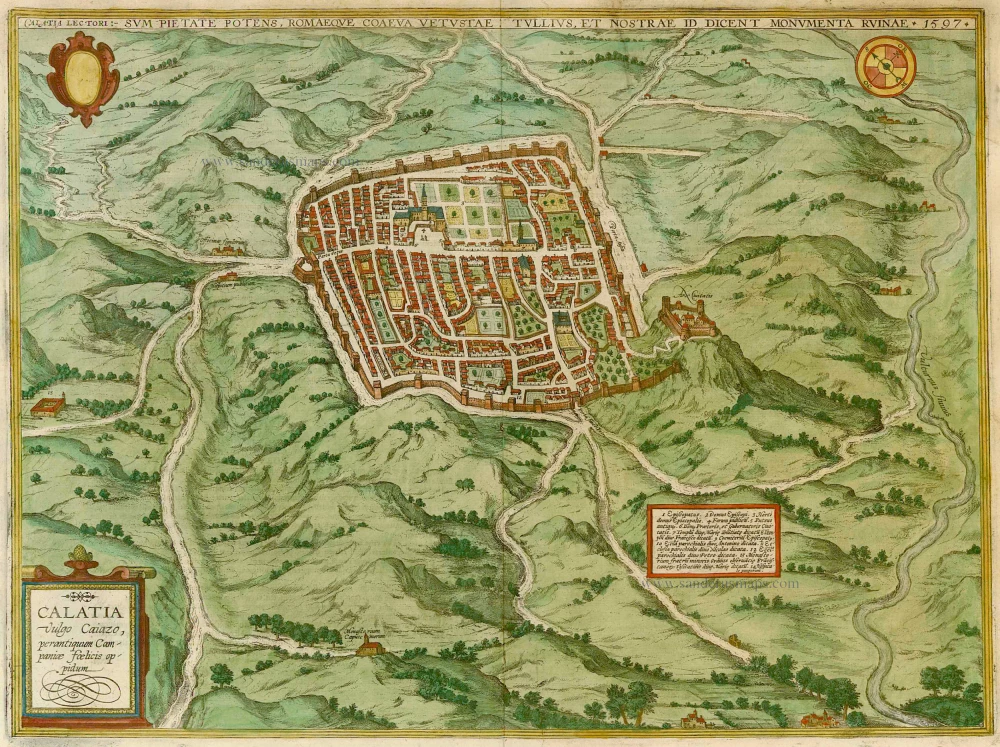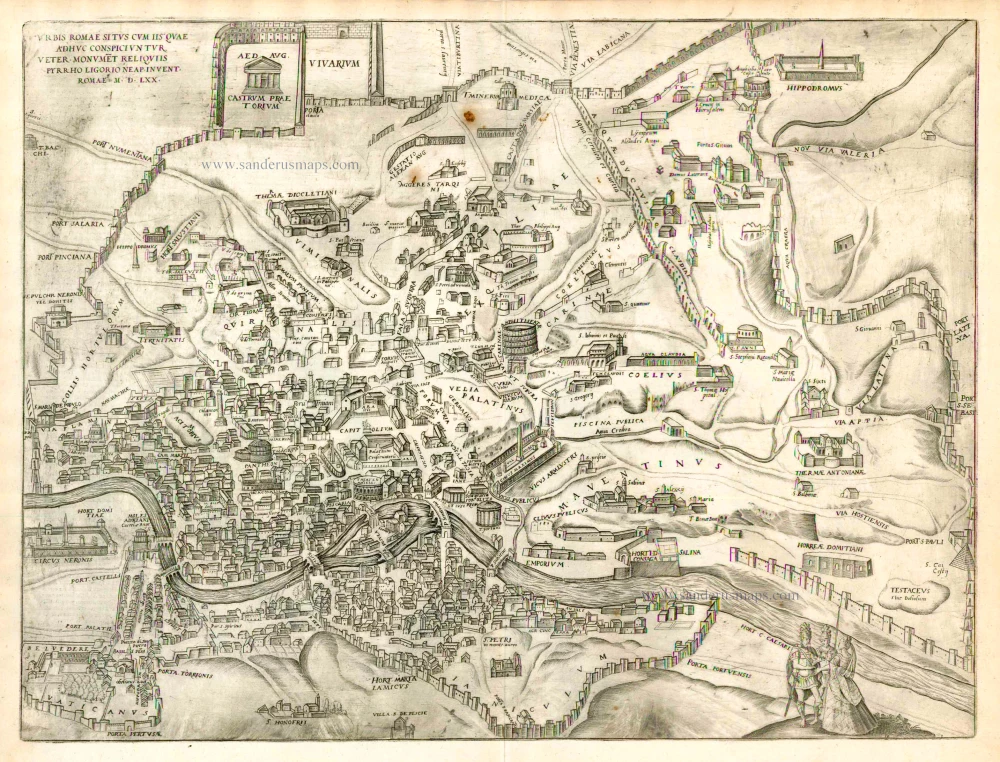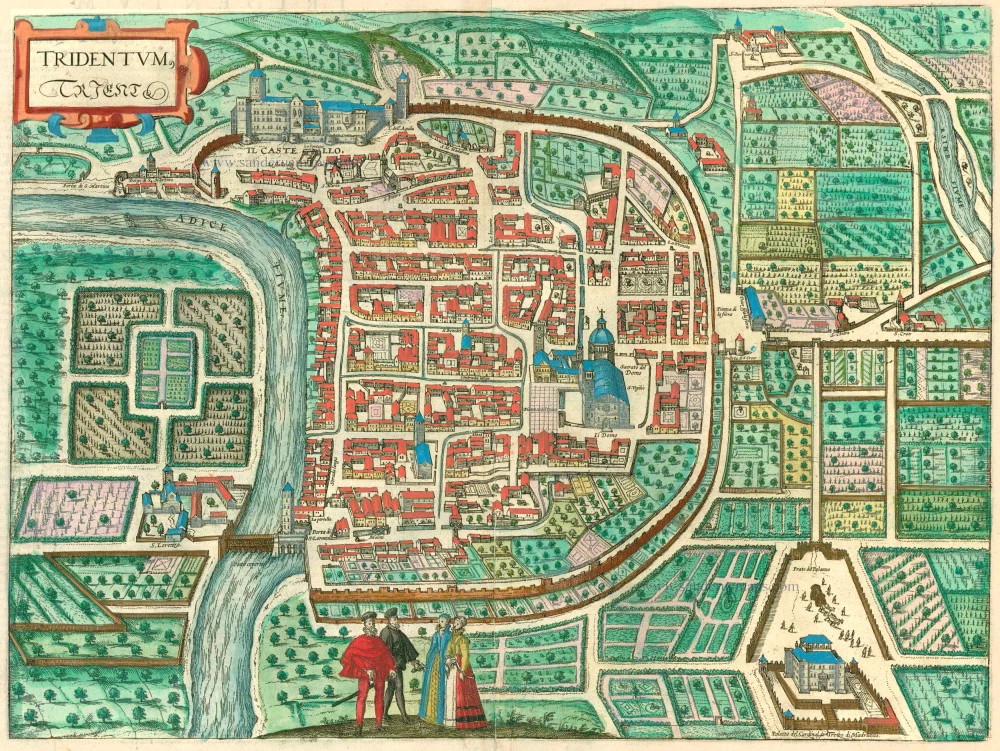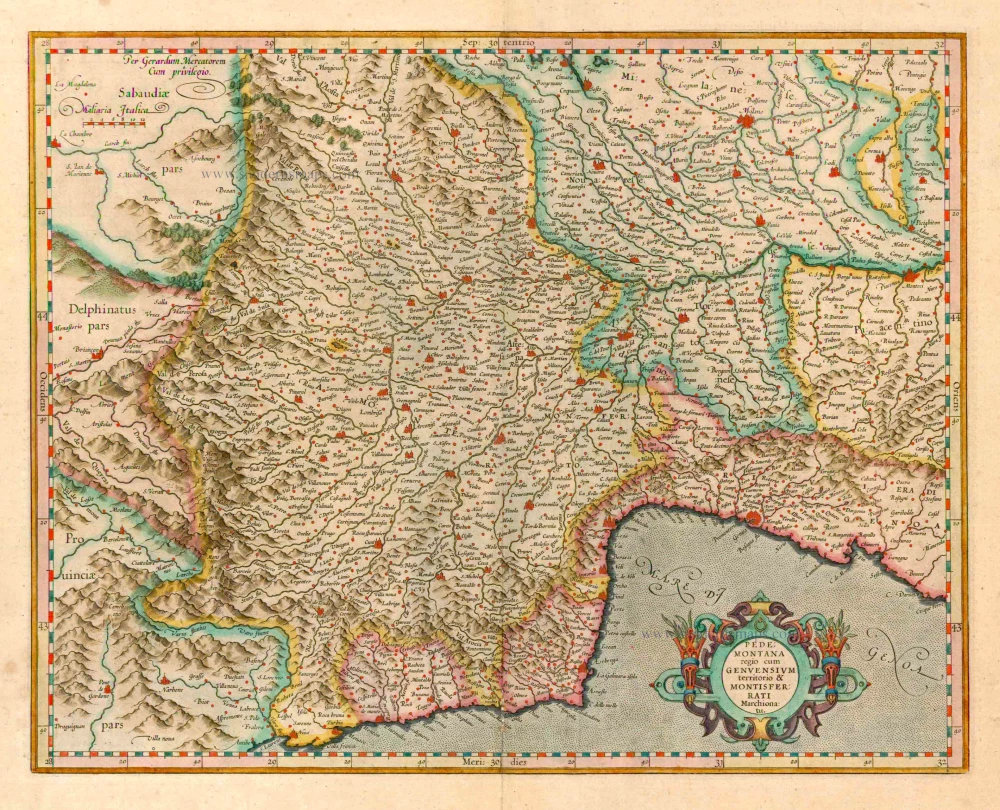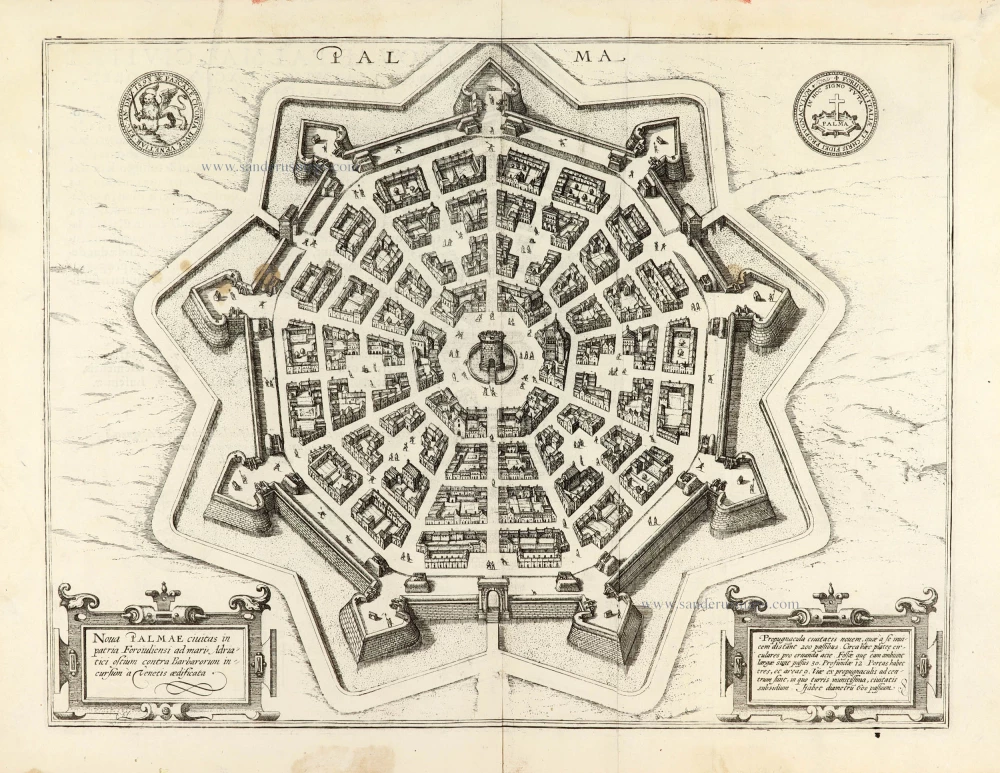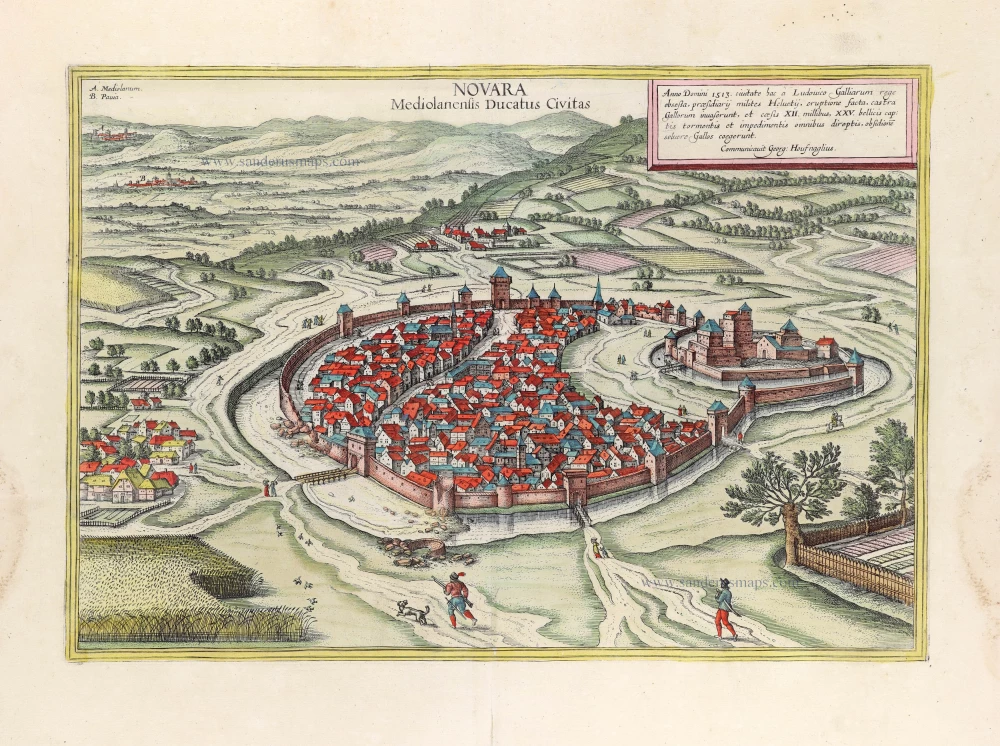Novara by Braun and Hogenberg. c. 1625
CAPTION: Novara, a city in the Duchy of Milan.
TRANSLATION OF CARTOUCHE TEXT: When this city was besieged by King Louis of France in 1513, the garrison consisting of Swiss soldiers made a sortie and invaded the French camp. They killed 12,000 soldiers, took 25,000 prisoners and captured all heavy weapons and war machines. In this way, they forced the French to end the siege. Procured by Georg Hoefnagel.
COMMENTARY BY BRAUN (on verso): "This city lies in Lombardy, called Insubria in Latin, but now commonly known as the Duchy of Milan, and is located on the border with Piedmont. [...] It was always ruled by the princes of Milan, first the Turriani, then the Visconti, then the Sforza, and also the kings of France, and has always been loyal to Milan, the capital."
This bird's-eye view from the east shows the narrowly enclosed city in a densely populated landscape, with Pavia (B) and Milan (A) in the background. Parts of the city wall have been damaged, and the moat has been dug but not completed - a reference to the armed conflicts in which the city was involved at the beginning of the 16th century when King Louis XII of France claimed Milan from Duke Ludovica Sforza and laid siege to Novara. Swiss troops helped the duke to victory in 1513. Visible in the castle, originally a Roman fortress that was rebuilt under Duke Galeazzo Maria Sforza in 1468. In the 7th century, the Roman city was the centre of a Lombardian duchy and, in the 9th century, a French county. In 1167, it joined the Lombard League and accepted the protection of Milan at the end of the 12th century. (Taschen)
Braun G. & Hogenberg F. and the Civitates Orbis Terrarum.
The Civitates Orbis Terrarum, also known as the 'Braun & Hogenberg', is a six-volume town atlas and the most excellent book of town views and plans ever published: 363 engravings, sometimes beautifully coloured. It was one of the best-selling works in the last quarter of the 16th century. Georg Braun, a skilled writer, wrote the text accompanying the plans and views on the verso. Many plates were engraved after the original drawings of a professional artist, Joris Hoefnagel (1542-1600). The first volume was published in Latin in 1572 and the sixth in 1617. Frans Hogenberg, a talented engraver, created the tables for volumes I through IV, and Simon van den Neuwel made those for volumes V and VI. Other contributors were cartographers Daniel Freese and Heinrich Rantzau, who provided valuable geographical information. Works by Jacob van Deventer, Sebastian Münster, and Johannes Stumpf were also used as references. Translations appeared in German and French, making the atlas accessible to a broader audience.
Since its original publication of volume 1 in 1572, the Civitates Orbis Terrarum has left an indelible mark on the history of cartography. Seven more editions followed the first volume in 1575, 1577, 1582, 1588, 1593, 1599, and 1612. Vol.2, initially released in 1575, saw subsequent editions in 1597 and 1612. The subsequent volumes, each a treasure trove of historical insights, graced the world in 1581, 1588, 1593, 1599, and 1606. The German translation of the first volume, a testament to its widespread appeal, debuted in 1574, followed by the French edition in 1575.
Several printers were involved: Theodor Graminaeus, Heinrich von Aich, Gottfried von Kempen, Johannis Sinniger, Bertram Buchholtz, and Peter von Brachel, all of whom worked in Cologne.
Georg Braun (1541-1622)
Georg Braun, the author of the text accompanying the plans and views in the Civitates Orbis Terrarum, was born in Cologne in 1541. After his studies in Cologne, he entered the Jesuit Order as a novice, indicating his commitment to learning and intellectual pursuits. In 1561, he obtained his bachelor's degree; in 1562, he received his Magister Artium, further demonstrating his academic achievements. Although he left the Jesuit Order, he continued his studies in theology, gaining a licentiate in theology. His theological background likely influenced the content and tone of the text in the Civitates Orbis Terrarum, adding a unique perspective to the work.
Frans Hogenberg (1535-1590)
Frans Hogenberg was a Flemish and German painter, engraver, and mapmaker. He was born in Mechelen as the son of Nicolaas Hogenberg.
By the end of the 1560s, Frans Hogenberg was employed upon Abraham Ortelius's Theatrum Orbis Terrarum, published in 1570; he is named an engraver of numerous maps. In 1568, he was banned from Antwerp by the Duke of Alva and travelled to London, where he stayed a few years before emigrating to Cologne. He immediately embarked on his two most important works, the Civitates, published in 1572 and the Geschichtsblätter, which appeared in several series from 1569 until about 1587.
Thanks to large-scale projects like the Geschichtsblätter and the Civitates, Hogenberg's social circumstances improved with each passing year. He died as a wealthy man in Cologne in 1590.
Novara Mediolanensis Ducatus Civitas
Item Number: 24530 Authenticity Guarantee
Category: Antique maps > Europe > Italy - Cities
Novara by Braun and Hogenberg.
Title: Novara Mediolanensis Ducatus Civitas
Communicavit Georg: Houfnaglius.
Date of the first edition: 1617.
Date of this map: c. 1625.
Copper engraving, printed on paper.
Size (not including margins): 325 x 475mm (12.8 x 18.7 inches).
Verso: French text.
Condition: Original coloured, excellent.
Condition Rating: A+.
From: Théatre des Principales Villes de tout l'Univers Vol. VI. c. 1625. (Van der Krogt 4, 41:3.6)
CAPTION: Novara, a city in the Duchy of Milan.
TRANSLATION OF CARTOUCHE TEXT: When this city was besieged by King Louis of France in 1513, the garrison consisting of Swiss soldiers made a sortie and invaded the French camp. They killed 12,000 soldiers, took 25,000 prisoners and captured all heavy weapons and war machines. In this way, they forced the French to end the siege. Procured by Georg Hoefnagel.
COMMENTARY BY BRAUN (on verso): "This city lies in Lombardy, called Insubria in Latin, but now commonly known as the Duchy of Milan, and is located on the border with Piedmont. [...] It was always ruled by the princes of Milan, first the Turriani, then the Visconti, then the Sforza, and also the kings of France, and has always been loyal to Milan, the capital."
This bird's-eye view from the east shows the narrowly enclosed city in a densely populated landscape, with Pavia (B) and Milan (A) in the background. Parts of the city wall have been damaged, and the moat has been dug but not completed - a reference to the armed conflicts in which the city was involved at the beginning of the 16th century when King Louis XII of France claimed Milan from Duke Ludovica Sforza and laid siege to Novara. Swiss troops helped the duke to victory in 1513. Visible in the castle, originally a Roman fortress that was rebuilt under Duke Galeazzo Maria Sforza in 1468. In the 7th century, the Roman city was the centre of a Lombardian duchy and, in the 9th century, a French county. In 1167, it joined the Lombard League and accepted the protection of Milan at the end of the 12th century. (Taschen)
Braun G. & Hogenberg F. and the Civitates Orbis Terrarum.
The Civitates Orbis Terrarum, also known as the 'Braun & Hogenberg', is a six-volume town atlas and the most excellent book of town views and plans ever published: 363 engravings, sometimes beautifully coloured. It was one of the best-selling works in the last quarter of the 16th century. Georg Braun, a skilled writer, wrote the text accompanying the plans and views on the verso. Many plates were engraved after the original drawings of a professional artist, Joris Hoefnagel (1542-1600). The first volume was published in Latin in 1572 and the sixth in 1617. Frans Hogenberg, a talented engraver, created the tables for volumes I through IV, and Simon van den Neuwel made those for volumes V and VI. Other contributors were cartographers Daniel Freese and Heinrich Rantzau, who provided valuable geographical information. Works by Jacob van Deventer, Sebastian Münster, and Johannes Stumpf were also used as references. Translations appeared in German and French, making the atlas accessible to a broader audience.
Since its original publication of volume 1 in 1572, the Civitates Orbis Terrarum has left an indelible mark on the history of cartography. Seven more editions followed the first volume in 1575, 1577, 1582, 1588, 1593, 1599, and 1612. Vol.2, initially released in 1575, saw subsequent editions in 1597 and 1612. The subsequent volumes, each a treasure trove of historical insights, graced the world in 1581, 1588, 1593, 1599, and 1606. The German translation of the first volume, a testament to its widespread appeal, debuted in 1574, followed by the French edition in 1575.
Several printers were involved: Theodor Graminaeus, Heinrich von Aich, Gottfried von Kempen, Johannis Sinniger, Bertram Buchholtz, and Peter von Brachel, all of whom worked in Cologne.
Georg Braun (1541-1622)
Georg Braun, the author of the text accompanying the plans and views in the Civitates Orbis Terrarum, was born in Cologne in 1541. After his studies in Cologne, he entered the Jesuit Order as a novice, indicating his commitment to learning and intellectual pursuits. In 1561, he obtained his bachelor's degree; in 1562, he received his Magister Artium, further demonstrating his academic achievements. Although he left the Jesuit Order, he continued his studies in theology, gaining a licentiate in theology. His theological background likely influenced the content and tone of the text in the Civitates Orbis Terrarum, adding a unique perspective to the work.
Frans Hogenberg (1535-1590)
Frans Hogenberg was a Flemish and German painter, engraver, and mapmaker. He was born in Mechelen as the son of Nicolaas Hogenberg.
By the end of the 1560s, Frans Hogenberg was employed upon Abraham Ortelius's Theatrum Orbis Terrarum, published in 1570; he is named an engraver of numerous maps. In 1568, he was banned from Antwerp by the Duke of Alva and travelled to London, where he stayed a few years before emigrating to Cologne. He immediately embarked on his two most important works, the Civitates, published in 1572 and the Geschichtsblätter, which appeared in several series from 1569 until about 1587.
Thanks to large-scale projects like the Geschichtsblätter and the Civitates, Hogenberg's social circumstances improved with each passing year. He died as a wealthy man in Cologne in 1590.

